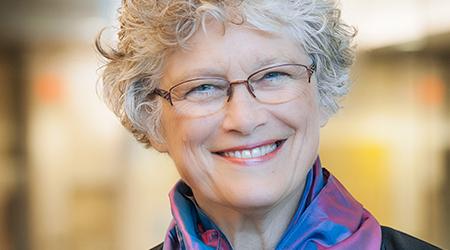Dr. Jerilynn Prior: Pioneering research in women’s health
21 March 2019

Dr. Jerilynn C. Prior has spent her career studying women’s menstrual cycles, perimenopause (the transition into menopause), menopause, and osteoporosis. A pioneer in the field, she founded and leads the world’s first and only women’s research and outreach centre focussing on ovulation and menstruation, and how they influence women’s health beyond fertility – the Centre for Menstrual Cycle and Ovulation Research (CeMCOR), part of UBC’s Division of Endocrinology.
On April 4, Dr. Prior will be presented with the 2019 Aubrey J. Tingle Prize in recognition of her contribution as a clinician-scientist to women’s health research and the health system in BC and globally. Here, she reflects on her journey from an isolated primarily First Nations fishing village in Alaska, and the revolutionary act of listening to women.
You’ve had a long and influential career, but let’s start at the beginning. How did you get started in health research?
It has truly been an arduous journey! My first memory of wanting a career in health was when a public health nurse visited the one-room school in our village in Alaska. She was there to give us vaccinations and ended up also providing treatment for lice! I thought that seemed like a cool job.
Later, with help from a National Science Foundation scholarship I studied liberal arts for two years pre-nursing school, decided to try for medicine but hedged my (weak) bet with a second major in English literature. I applied for and was rejected nine times before getting into medical school, one of six women in a class of 88. I graduated with honours. Although I knew no woman physicians during my first two years of medical school and after that, none who were married and had a family, I always believed it was what I was meant to do.
It was actually when I first started university that I began thinking about women’s health and the menstrual cycle. I missed my period for nine months, and although I told no-one, I puzzled about why, when I wasn’t pregnant and felt healthy, well-fed and happy, my period had disappeared.
That was when I first realized the importance of hypothalamic-pituitary-ovarian system that assesses potential threats or stresses, and can temporarily either pause your menstrual cycle or silently disturb ovulation in a way that is primarily protective but, if chronic, can have long term negative impacts on women’s health.
And why do these silent disturbances matter?
Silent ovulatory disturbances within regular, normal-length menstrual cycles are a major hidden risk for women’s osteoporosis, heart disease (in the first 10 years of menopause) and breast cancer. Silent disturbances can mean either a cycle where no egg is released, or one where the luteal phase (the time between ovulation and the next flow) is too short, progesterone levels are too low and fertility is temporarily prevented.
This is common, especially in adolescence. It’s a problem because it not only causes decreased fertility, but because normal levels of both estrogen and progesterone are needed to prevent bone loss and osteoporosis after the teenage years. Normally ovulatory cycles also appear to decrease women’s heart attacks in their 50s and 60s and to prevent endometrial and breast cancers later in life. It is also likely that normally ovulatory cycles aid in stroke and dementia prevention.
One of my biggest achievements is documenting the importance of progesterone as estrogen’s menstrual cycle ‘partner’ hormone. Previously, regular cycles were always assumed to be ovulatory and estrogen was the primary focus.
You started the Centre for Menstrual Cycle and Ovulation Research (CeMCOR) at the University of British Columbia in 2002. What drove you to take that step?
For decades I had been doing research in this area and getting results that contradicted a lot of the established knowledge in the field. Women would come to me asking for help about everything from menstrual cycles and fertility, to perimenopause and menopause because they couldn’t get the information they needed anywhere else. I was saying the same things over and over again so I started making handouts that have since popped up all over the globe.
I knew that to further this research and change the very paternalistic authority-based ‘knowledge’ about women’s reproduction, we needed to bring together researchers from many fields who were willing to collaborate. I also realized that we had to incorporate knowledge translation to women in ways that were more effective than my public lectures and mimeographed handouts.
That was the starting point for CeMCOR which was, and still is, the only women’s research and outreach centre focussing on ovulation, as well as menstruation, and how they influence women’s health beyond fertility.
So you were doing knowledge translation long before it became a buzzword.
I think the key thing I have done is listen to women, seek to understand what they are going through and then try to figure out why it is happening. It really shouldn’t be unique to listen to women, and it shouldn’t be unique to try and figure out what matters to them, but apparently it is. I just thought it’s what ought to be done.
Much of the established knowledge in women’s menstrual health, and the care provided is not really based in documented evidence or scientific data. Even worse, many problems or concerns are still dismissed as ‘trivial’. That’s what we’re trying to fix.
So as well as sharing our research with the academic world to try and improve scientific understanding, we’re also educating and empowering women so they can ask for the treatment and care they need.
One way we do that is through the CeMCOR website which provides information for adolescent, premenopausal, perimenopausal and menopausal women, as well as for healthcare providers and for researchers. We have things like our ‘Ask Us’ postings, where we publish answers to individual women’s (anonymized) questions. I also wrote a novel, Estrogen’s Storm Season – stories of perimenopause, to help symptomatic midlife women understand the mysterious and challenging changes that they are experiencing and learn things that will help.
It sounds like we have come a long way, but there is still a long way to go. What is the next big question that needs solving, or next big advance that is needed in this area of research?
There are lots! We still need a simple, non-invasive and inexpensive test that can tell young women, cycle by cycle, if they are ovulating so they can seek help early related to fertility and prevent long-term health risks. We also need randomized controlled trials of progesterone treatment for menstrual cycle and ovulatory disturbances, and for conditions like polycystic ovary syndrome in order to ensure we are providing the best care possible. Beyond that, we need controlled trials of progesterone with standard bone-loss preventing osteoporosis treatments to see whether or not bone density improves and fractures are prevented.
But perhaps most importantly we need to view normal ovulation, as well as menstruation, as essential for women’s health, not something that is too awkward for polite conversation.
The Aubrey J. Tingle Prize is a validation of the work I’ve done over the years, work that has often gone un-validated because of the field. Since its creation, we have proven the scientific value of CeMCOR’s research and the website – which often garners 5,000 page-views a day from >160 countries. We are based at the University of British Columbia and when I eventually retire the CeMCOR will need new leadership and support for the infrastructure to allow scientists to continue this key work for half of our population.
Women need to be heard, we need scientific answers and we need to be treated using the best, most up-to-date knowledge. Sadly that is still not happening. So yes, there is still a lot of work to be done.
The 2019 Aubrey J. Tingle Prize was presented on April 4 at the 21st Annual LifeSciences BC Awards.





